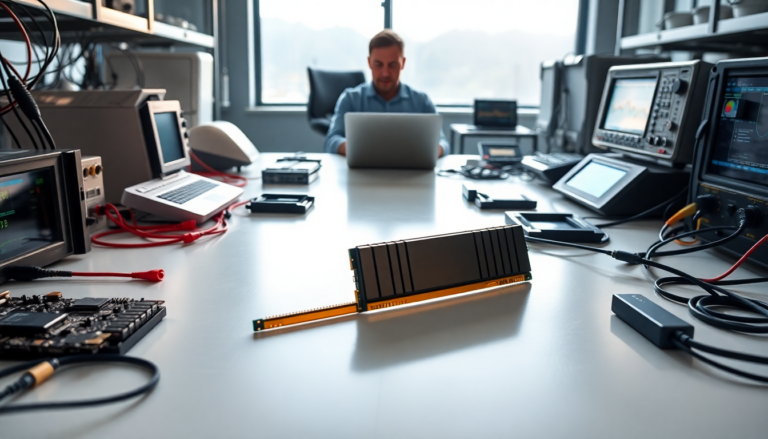Argomenti trattati
The landscape of memory technology is on the brink of a major shift with the arrival of **CAMM2 memory modules**. As technology races forward, the need for **higher performance and efficiency** in computing has never been more critical. Recently, **G.Skill**, a leader in high-performance memory solutions, has made headlines by achieving an impressive overclocking milestone with CAMM2. This innovative memory standard aims to replace traditional SO-DIMM and UDIMM formats, paving the way for a faster and more streamlined approach to memory in our devices. But what does this mean for the future of computing?
The Current State of Memory Technology and the CAMM2 Breakthrough
So, where does CAMM2 fit into the current memory landscape? The CAMM2 standard is set to redefine **performance benchmarks** within the industry. G.Skill recently made waves by stabilizing memory speeds at **DDR5-10000** using a 64GB CAMM2 module, in tandem with a specially designed **Asus ROG Maximus Z890 Hero CAMM2 motherboard** and an **Intel Core Ultra 7 265K CPU**. This milestone signifies a substantial leap from existing JEDEC specifications for DDR5, which typically range from 4800 to 8800 MT/s. While the current record for DDR5 memory stands at an astounding **DDR5-12054**, achieved by a Canadian overclocker, CAMM2’s design is inherently optimized for higher speeds compared to traditional SO-DIMM options. Isn’t it exciting to think about how far we’ve come?
However, there’s a catch. Despite its clear advantages, the availability of CAMM2 modules and compatible motherboards is still somewhat limited. While manufacturers like G.Skill, TeamGroup, and Kingston have showcased CAMM2 at various tech expos, retail availability remains a work in progress. Currently, **Crucial** is the only vendor offering CAMM2 kits, specifically the **LPCAMM2 LPDDR5X-7500** in 32GB and 64GB capacities. This scarcity highlights the transitional phase of the CAMM2 standard as it carves out its niche in the market. Are we ready for this new era, or is it still too early to tell?
Advantages of CAMM2 and Its Implications for Future Computing
What makes CAMM2 stand out? This new form factor boasts several advantages that appeal to both manufacturers and consumers. One of the standout features is its **compact size**, allowing laptop and handheld device manufacturers to move away from soldered RAM configurations. By using **LPCAMM2 modules**, these devices can provide greater **upgradability** and **repairability** without compromising on size or thickness. This shift not only enhances user experience but could also lower manufacturing costs by simplifying production lines. How cool would it be to upgrade your laptop’s memory without the hassle?
Looking ahead, the integration of CAMM2 into mainstream computing appears promising, albeit at a gradual pace. The existing dominance of **DIMM technology**, a staple since the early 1990s, presents challenges for CAMM2’s rapid adoption. However, as the demand for advanced computing capabilities surges—especially in fields like **artificial intelligence** and **high-performance gaming**—the likelihood of CAMM2 taking center stage increases. Its ability to meet these demands will be vital in determining its success in the future market. Can CAMM2 truly live up to the hype?
Conclusion: A Transformative Era for Memory Technology
The journey of CAMM2 from a conceptual innovation to a mainstream memory solution is still unfolding, yet its potential is undeniable. As the industry evolves, transitioning to CAMM2 could lead to substantial advancements in performance and efficiency across various applications. For tech enthusiasts and industry professionals, keeping an eye on developments surrounding CAMM2 is crucial, as it promises to unlock new possibilities in the world of computing technology. Are you ready to embrace the future of memory?

